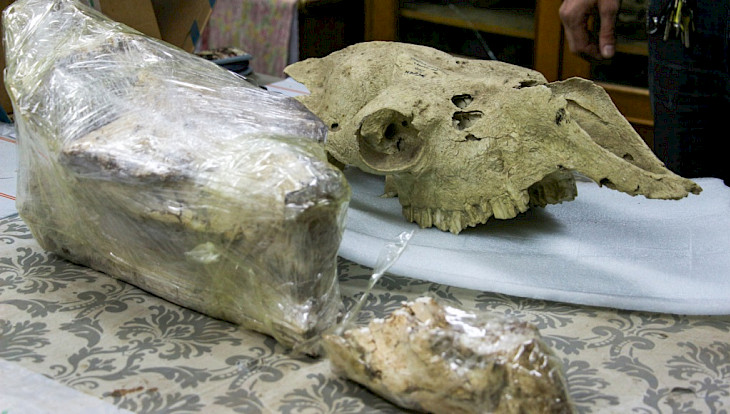A joint group of paleontologists from Russia and Tajikistan has made a unique discovery in the Kuruk Say ravine (Tajikistan) - the complete skull of a camel from the early Pleistocene period (2.5 million years ago), Asiaplustj.info reports.
The find is highly valuable since usually only separate parts of the skull or bones are discovered, whereas this skull was found intact, according to the report.
"We were very lucky because bones throughout the entire territory of Asia are poorly preserved, even those that are only 2,000 years old. They are like chalk, extremely fragile. If you accidentally touch the bone without pre-processing, it crumbles into small pieces," noted Dmitry Gimranov, a scientist from Ural Federal University (UrFU) and the Ural Branch of the Russian Academy of Sciences (RAS).
To preserve the skull, it was completely glued and fixed with film on-site during the excavations. This allowed the find to be transported to the Urals for restoration and study (for three years, after which the skull will be returned to Tajikistan for further research), explained Gimranov.
The Kuruk Say ravine is located in the Matchinsky district of the Sughd region of Tajikistan.
"The skull was transported in a carry-on box," explained Dmitry Gimranov. "But the frontal part of the skull still fell off. The skull weighs almost 20 kg because inside, there is loess - sedimentary mountain rock, similar to heavy solid clay."
Scientists note that from such ancient remains, it is possible to understand what the camel ate, the size of its brain, and more.
"If we compare the found skull with modern camels, the sizes are approximately the same," said Gimranov.
UrFU specialists already claim that during the early Pleistocene period, savannah-like landscapes spread across Tajikistan, with a climate similar to modern North Africa. Scientists suggest that camels adapted to this era did not have characteristic humps. In favorable conditions, they did not need a long-term supply of nutritional resources.
Accompanying discoveries in the Kuruk Say ravine also indicate a different climate in Tajikistan during that period.
In addition to the camel skull, paleontologists found the bones of a giant short-faced hyena, Issyk lynx, Etruscan wolf, rhinoceros, raccoon-like dog, sabertooth cat, Stenon-like horse, several species of deer, antelope, and gazelle.
CentralasianLIGHT.org
November 30, 2023

